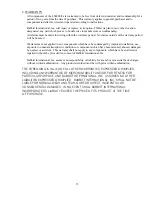
“POR” is used to select the “POWER-ON-RESET” mode of the LS8000/2 if the supply voltage should be
interrupted while the fluid level is between the low and high setpoints. If the unit should lose power, and the
level is between the setpoints, the LS8000/2 can not “remember” if it was filling or emptying at the time of
power loss. By properly setting “POR” for your application, the relay will either energize or de-energize when
power is restored to the unit. If the fluid level is below the low setpoint or above the high setpoint, “POR” has
no effect on the operation of the unit.
The following chart will help you set “POR” and “LATCH”:
POR LATCH FILL/EMPTY
Latching Relay Status Power On Reset
UP
UP
AUTO FILL
RELAY OFF
DOWN
UP
AUTO FILL
RELAY ON
DOWN
DOWN
AUTO EMPTY
RELAY OFF
UP
DOWN
AUTO EMPTY
RELAY ON
C. Calibrate the Low Setpoint
There are two ways to calibrate the low setpoint. Method “A” puts the setpoint on the bottom tip of the probe.
Method “B” is for applications where the low setpoint needs to be above the tip of the probe.
METHOD “A”
1. When material IS NOT in contact with the probe, observe the red LED for the low setpoint. If it is
on, go to step 3.
2. If the red LED for the low setpoint is off, turn the low adjustment potentiometer (SP1) CW
(clockwise) until it comes on.
3. Turn the low adjustment potentiometer (SP1) CCW (counter-clockwise) until the low red LED
just goes out.
METHOD “B”
1. Raise the fluid level to where you want the low setpoint to be on the probe.
2. Observe the red LED for the low setpoint. If it is off, go to step 4.
3. If the red LED is on, turn the low adjustment potentiometer (SP1) CCW until the red LED goes
out.
4. Turn the low adjustment potentiometer CW until the low red LED just comes on.
D. Calibrate the High Setpoint
As a rule of thumb, clockwise (CW) rotation of the pot lowers the setpoint; counter-clockwise (CCW) rotation
of the potentiometer raises the setpoint.
1) Raise the fluid level to where you want the high setpoint to be on the probe.
2) Observe the high red LED. If it is off, go to step 4.
3) If the high red LED is on, turn the high adjustment pot (SP2) CCW until the high red LED goes out.
4) Turn the high adjustment pot (SP2) CW until the high red LED just comes on. This adjustment must be
made very carefully.
NOTE:
Always fill and empty the vessel to verify the accuracy of the calibration. Repeat the above
procedure if necessary. Contact your local distributor or the factory if you have any questions.
E. 2 PROBE CALIBRATION
If you are using 2 transmitters and probes, they are both calibrated the same way.
SP1 potentiometer calibrates the transmitter and probe hooked to S1 terminal
and the output is setpoint 1 relay.
SP2 potentiometer calibrates the transmitter and probe hooked to S2 terminal
and the output is setpoint 2 relay. The following should be done to SP1 and SP2 independently WHEN NO
MATERIAL IS IN CONTACT WITH THE PROBE.
1. Observe the red LED next to the potentiometer you are setting. If it is on, go to step 3.
2. If the red LED is off, turn the potentiometer CW until it comes on.
3. Turn the potentiometer CCW until the red LED just goes out. If this is too sensitive for your application
you can turn the potentiometer ¼ to 1 turn further CCW to make the probe less sensitive.
NOTE:
Always fill and empty the vessel to verify the accuracy of the calibration. Repeat the above
procedure if necessary. Contact your local distributor or the factory if you have any questions.
13



































